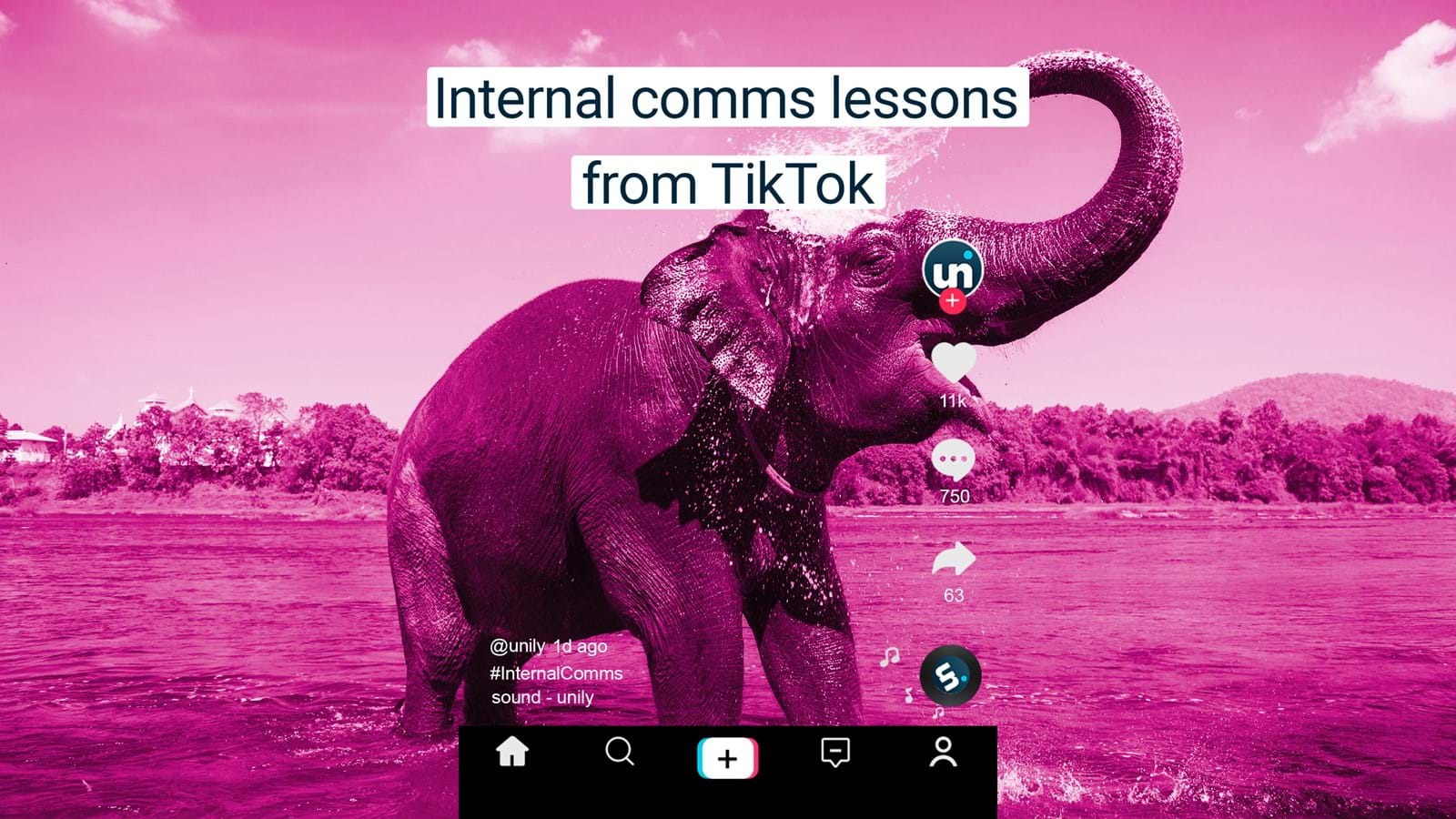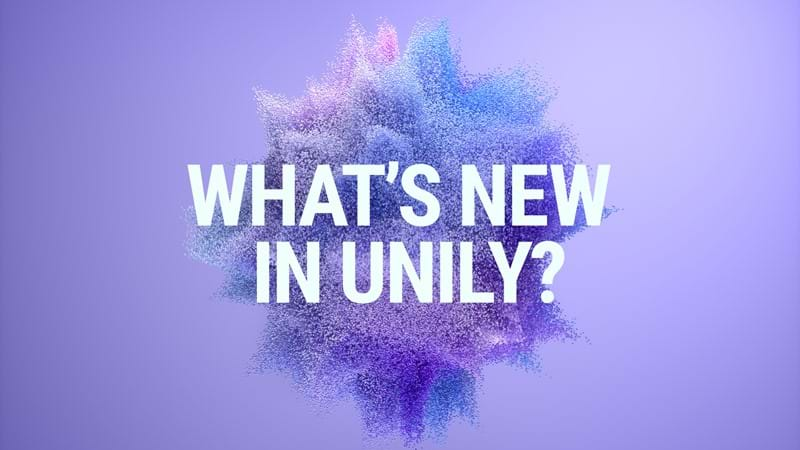Internal communications lessons from TikTok: Why you shouldn't feed elephants to employees
Competing for employees' attention isn't easy. With the rise of short-form communications and microcontent styles, combined with shortening attention spans and increasing volume of communications, internal communication strategies are in need of a revamp. What lessons can internal communicators learn from the consumer trends to engage employees and cut through noise?

The TikTok effect
At the start of the pandemic, TikTok reported 188 million new users – a year-on-year increase of 70%. It is now the seventh-largest platform in terms of users, ahead of others that have been around much longer such as Snapchat, Pinterest, and Twitter. And while it's true that TikTok is primarily targeted at younger users, in less than 18 months the number of US adult TikTok users grew 5.5x, now sitting at 14.3m.
It's not just your future employees that are having their consumption habits shaped by TikTok, the impact is pervasive.
So, what do we know about how TikTok works and why garnering such a dedicated audience? And what can internal communicators learn about engaging employees from the app that makes users spend 52 minutes per day consuming content and where 9/10 return multiple times a day?
The reasons TikTok works:
- Shortform content - videos are a maximum length of 60 seconds, forcing creators to clarify their message quickly and be creative with delivery, and ensuring users get digestible insights
- Ease of content creation - practically anyone can become a content provider because of the simplicity of using the app, meaning new content floods the platform continuously
- Powerful recommendations - TikTok's superpower hides within its algorithms that learn from user behavior to provide personalized experiences that tightly cater to a user's interests, keeping them engaged for longer
- User-generated content - UGC is the reason all our favorite social platforms have taken off, but TikTok is clear that it was made for content creators. Its success predicated on the appetite for user-generated content, both to create it and watch it
- Authentic voices - TikTok makes it easy for users to create content on the fly, which creates a sense of authenticity that helps users trust the information they are being given and build connections with creators
- Community features - You can't talk about what works about TikTok without mentioning 'TikTok trends'. The reason TikToks go viral is that the app encourages users to interact with each other's content. Where previously copying content ideas from creators was considered theft of IP, TikTok turns this idea on its head to incredible effect. By actively prompting users to respond to content with their own spin-off versions, TikTok creates the conditions for a small idea to grow exponentially in whichever way the community sees fit
- Power to the users - TikTok users are powerful. As a community, they know they have the power to shape conversations and influence consumer habits. They see the impact of getting involved in conversations and as a result, they feel empowered by technology
The success of TikTok is proof that even the most tried-and-tested engagement principles can be rewritten when technology creates the opportunity to better cater to user demands. With more than 1 million videos viewed on TikTok every day, it's time to consider what you can learn from consumer trends to keep your internal communications fresh and ahead of the curve.
Communications challenges emerge in the new world of work
2020 was a busy year for internal comms teams. During the pandemic, the volume of employee emails increased by more than 100% according to research by Ragan. Rather than slowing down, the pace of internal messaging is only going to further accelerate throughout 2021 as enterprises lean on their communications teams to transition to their next normal.
While constant updates were needed during the height of the pandemic, nonstop messaging took its toll. As meetings stretched on an average of 10 minutes longer and workers participated in 45% more virtual chats, overall digital intensity began to climb. After a year of communications overdrive, more than 54% of employees reported feeling overworked and nearly 40% are exhausted.
This uptick in messaging fatigue comes at a troubling time. Just as internal communications teams are crafting strategies to prepare for the future of work, their audiences are hitting the wall. As attention spans dwindle and stakes rise, internal communicators will need to get creative to reach their colleagues.
Taking inspiration from the best of customer marketing
Old communications tactics are going fall flat in the new world of work because your audience isn’t just busier; they’re also smarter. Over the last year, businesses have leveraged digital technology to engage consumers in new and exciting ways and their hard work is paying off. Ecommerce is spiking, digital adoption accelerated at the rate of five years in just two months, and 67% of customers now expect companies to anticipate their needs.
Since your people are not just employees, but also savvy consumers, these expectations are making their way into the workplace. Omnichannel marketing strategies, which are linked with a 10% increase in consumer spending, can be recreated to have a similarly positive impact on workplace engagement.
While you may have relied on segmented mediums in years past, your audience now expects integrated messaging experiences that are underpinned by next-generation technology. When it comes to launching your workplace’s omnichannel strategy, intranets have emerged as a vital tool for internal comms teams. Modern solutions provide a central hub that makes it easier than ever to launch messaging experiences that mimic what your colleagues have grown accustomed to as consumers.
6 consumer-inspired trends to revamp internal communications
While the right digital channels can serve as the foundation for strong internal communications, it takes more than technological infrastructure to craft engaging messaging strategies. Internal communicators can weave some creativity into their approach by pulling from marketing’s best practices, including:
#1. Keep it short and visual
As our own Paul Seda notes in a recent podcast episode on consumer-grade comms, “You don’t want to feed elephants to your employees”. Despite this advice, many companies are continuing to send out complex messages that are difficult to digest. Only 48% of communications collateral is considered easy to process, according to a recent Gartner report.
Instead of overloading your people with messages that are filled with extraneous information, strive to keep content simple and to the point. This will prove particularly beneficial for your millennial and Gen Z employees, whose attention spans are only 12 and 8 seconds, respectively. While it’s unclear if TikTok is to blame, it can’t hurt to take some inspiration from the platform and amplify key messages with concise video content that your colleagues can easily share with their peers.
#2. Identify your own influencers
Influencer marketing has taken consumer communications by storm. Since 2016, influencer marketing has grown by nearly 50% each year, with the market size increasing to nearly 10b in 2020.
What lessons can internal communicators learn from this runaway success? Namely, that messages are more powerful when they come from people that your audience looks up to or trusts.
While it may not be possible to recruit a Kardashian for your internal messaging campaign, that doesn’t mean you can’t take advantage of influencers within your own network. Every company has its own internal ambassadors, or employees who are engaged and actively promote your organization to colleagues and friends. Internal communicators can tap these impassioned employees to produce their own user-generated content that will help get key messages across and even give them some recognition via kudos and badges on their intranet.
#3. Put a premium on authenticity
Many enterprises are facing a trust issue. 48% of Americans don’t trust for-profit companies and 69% think building trust should be a top priority for businesses of today.
Savvy companies have already taken this issue to heart and many are launching marketing campaigns that focus on transparent communications and uplifting stories. Throughout 2020, inspirational advertisements gained massive popularity, including an example by Nike showcasing comeback stories of world class athletes, followed by a message that encourages customers to stay active and safe by working out at home.
By incorporating a more human angle and weaving in messaging that aligned with health and safety protocols at the time, Nike’s customers were on the receiving end of a message that felt authentic and grounded in truth. Internal communicators can take a page from the brand’s playbook by producing content that speaks to employees as people. Acknowledge how your audience is feeling, lead with the facts, and let trusted leaders communicate major news updates directly to your people via town halls and videos.
#4. Remember the rule of seven
While no one wants to sound like a broken record, it can actually be beneficial to repeat your message a few times using different mediums. In fact, there’s a marketing rule that suggests that individuals need to hear something seven times before they will consider taking action.
Your colleagues consume information differently. Some may gravitate towards email updates while others will prefer hearing something directly from your CEO. Rather than choosing one medium for pressing messages, tap into multiple channels so that your audience sees a consistent message across multiple platforms.
#5. Give everyone a say
Passive audiences are becoming a thing of the past. On the consumer side, major brands are regularly encouraging customers to engage with their messaging. One of our own clients, leading quick-service fast-casual chain Zaxby’s, recently started a movement on Random Acts of Kindness Day. The enterprise launched an innovative TikTok campaign that inspired customers to find their own ways to participate.
Internally, the communications pendulum has swung from favoring top-down messaging to embracing two-way channels. Internal comms teams are now leveraging employee social networking tools, which have been linked with a 20% increase in workplace satisfaction. If you’re looking to boost engagement in the new world of work, take advantage of features like liking, commenting, and reacting to give everyone a chance to participate in the conversations you’re having.
#6. Make it mobile
The mobile movement shows no signs of slowing down. In fact, the share of users accessing content via a mobile device increased by 10% last year and web access from mobile and tablet devices has officially surpassed desktops since 2016. The consumer apps flooding the market are changing your employees' expectations of how and when they want to be communicated with, and as a result, more enterprises are choosing to leverage mobile as a key communication channel. With a mobile platform for communicating with employees, you empower the workforce with on-demand access to knowledge in everyone's pocket.
Mobile communications are particularly important for workforces with a significant frontline presence, such as airlines and retail enterprises. For these enterprises, a mobile intranet app provides a universal touchpoint that keeps employees informed and connected, no matter where their job takes them.

Are you ready to level up your internal comms strategy?
As your enterprise prepares for your next chapter, the need for relevant internal comms that resonate will reach a peak. Find out how leading enterprises are transforming internal communications.
Get started. Get your free demo.
Supercharge your internal communications with Unily.















